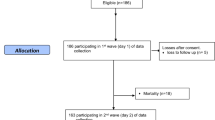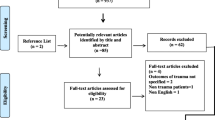Abstract
Background
The procalcitonin/albumin ratio (PAR), a novel inflammation-based index, has been reported to predict the prognosis following cardiopulmonary bypass surgery and bacterial infection. However, whether PAR can predict the outcome of patients with severe traumatic brain injury (STBI) has not been fully elucidated. This study aimed to investigate the relationship between serum PAR levels and prognosis at 6 months after STBI.
Methods
We retrospectively enrolled 129 patients diagnosed with STBI and collected relevant clinical and laboratory data. Logistic regression analysis was used to estimate the association of PAR with the prognosis of STBI. The receiver operating characteristics curve was performed to examine the predictive use of PAR for prognosis. Propensity score matching (PSM) analysis was also performed to improve the reliability of the results. The primary outcome measures were expressed as a score on the modified Rankin Scale at 6 months.
Results
The unfavorable prognosis group had advanced age, lower Glasgow Coma Scale score, higher rate of cerebral hernia and intracranial infection, higher neutrophil/lymphocyte ratio (NLR) and C-reactive protein/albumin ratio (CAR), elevated PAR, and higher rate of pneumonia. Multivariate analysis showed that PAR (before PSM: odds ratio 3.473, 95% confidence interval 2.983–4.043, P < 0.001; after PSM: odds ratio 5.358, 95% confidence interval 3.689–6.491, P < 0.001) was independently associated with unfavorable outcome. The area under the curve of the PAR for predicting an unfavorable outcome was higher than that of the CAR and NLR.
Conclusions
The PAR might be a novel independent risk factor of the outcome after STBI. Moreover, PAR was a better biomarker in predicting the outcome of patients with STBI than CAR and NLR.



Similar content being viewed by others
References
Steyerberg EW, Wiegers E, Sewalt C, et al. Case-mix, care pathways, and outcomes in patients with traumatic brain injury in CENTER-TBI: a European prospective, multicentre, longitudinal, cohort study. Lancet Neurol. 2019;18(10):923–34.
Mubashir T, Ahmad HS, Lai H, et al. Effect of obstructive sleep apnea on outcomes after traumatic brain injury: a retrospective cohort analysis. Neurocrit Care. 2022;37(1):228–35.
Komisarow JM, Toro C, Curley J, et al. Utilization of brain tissue oxygenation monitoring and association with mortality following severe traumatic brain injury. Neurocrit Care. 2022;36(2):350–6.
Lingsma HF, Roozenbeek B, Steyerberg EW, Murray GD, Maas AI. Early prognosis in traumatic brain injury: from prophecies to predictions. Lancet Neurol. 2010;9(5):543–54.
Vikse J, Henry BM, Roy J, et al. The role of serum procalcitonin in the diagnosis of bacterial meningitis in adults: a systematic review and meta-analysis. Int J Infect Dis. 2015;38:68–76.
Wanner GA, et al. Relationship between procalcitonin plasma levels and severity of injury, sepsis, organ failure, and mortality in injured patients. Crit Care Med. 2000;28(4):950–7.
Mimoz O, Benoist JF, Edouard AR, et al. Procalcitonin and C-reactive protein during the early posttraumatic systemic inflammatory response syndrome. Intensive Care Med. 1998;24(2):185–8.
Wang YR, Zheng QB, Wei GF, et al. Elevated PCT at ICU discharge predicts poor prognosis in patients with severe traumatic brain injury: a retrospective cohort study. J Int Med Res. 2020;48(5):300060520922456.
Veldeman M, Lepore D, Hollig A, et al. Procalcitonin in the context of delayed cerebral ischemia after aneurysmal subarachnoid hemorrhage. J Neurosurg. 2020;135:1–9.
Wang C, Gao L, Zhang ZG, et al. Procalcitonin is a stronger predictor of long-term functional outcome and mortality than high-sensitivity C-reactive protein in patients with ischemic stroke. Mol Neurobiol. 2016;53(3):1509–17.
Goyal K, Tomar GS, Sengar K, et al. Prognostic value of serially estimated serum procalcitonin levels in traumatic brain injury patients with or without extra cranial injury on early in-hospital mortality: a longitudinal observational study. Neurocrit Care. 2021;34(1):182–92.
Montalcini T, Moraca M, Ferro Y, et al. Nutritional parameters predicting pressure ulcers and short-term mortality in patients with minimal conscious state as a result of traumatic and non-traumatic acquired brain injury. J Transl Med. 2015;13:305.
Deng S, Gao J, Zhao Z, et al. Albumin/procalcitonin ratio is a sensitive early marker of nosocomial blood stream infection in patients with intra-cerebral hemorrhage. Surg Infect (Larchmt). 2019;20(8):643–9.
Luo X, Yang X, Li J, et al. The procalcitonin/albumin ratio as an early diagnostic predictor in discriminating urosepsis from patients with febrile urinary tract infection. Medicine (Baltimore). 2018;97(28): e11078.
Fritz HG, Brandes H, Bredle DL, et al. Post-operative hypoalbuminaemia and procalcitonin elevation for prediction of outcome in cardiopulmonary bypass surgery. Acta Anaesthesiol Scand. 2003;47(10):1276–83.
Higashikawa T, Okuro M, Ishigami K, et al. Procalcitonin and albumin as prognostic biomarkers in elderly patients with a risk of bacterial infection. J Int Med Res. 2018;46(7):2606–14.
Hanley JA, McNeil BJ. The meaning and use of the area under a receiver operating characteristic (ROC) curve. Radiology. 1982;143(1):29–36.
AlRawahi AN, AlHinai FA, Doig CJ, et al. The prognostic value of serum procalcitonin measurements in critically injured patients: a systematic review. Crit Care. 2019;23(1):390.
Maruna P, Nedelnikova K, Gurlich R. Physiology and genetics of procalcitonin. Physiol Res. 2000;49(Suppl 1):S57-61.
Luyt CE, Guerin V, Combes A, et al. Procalcitonin kinetics as a prognostic marker of ventilator-associated pneumonia. Am J Respir Crit Care Med. 2005;171(1):48–53.
Deng WJ, Shen RL, Li M, Teng JF. Relationship between procalcitonin serum levels and functional outcome in stroke patients. Cell Mol Neurobiol. 2015;35(3):355–61.
Vallet H, Chenevier-Gobeaux C, Villain C, et al. Prognostic value of serum procalcitonin after orthopedic surgery in the elderly population. J Gerontol A Biol Sci Med Sci. 2017;72(3):438–43.
Chen D, Bao L, Lu SQ, Xu F. Serum albumin and prealbumin predict the poor outcome of traumatic brain injury. PLoS ONE. 2014;9(3): e93167.
Li Y, Liu C, Luo X, et al. Controlling nutritional status score and prognostic nutrition index predict the outcome after severe traumatic brain injury. Nutr Neurosci. 2022;25(4):690–7.
Bernard F, Al-Tamimi YZ, Chatfield D, et al. Serum albumin level as a predictor of outcome in traumatic brain injury: potential for treatment. J Trauma. 2008;64(4):872–5.
Limaye K, Yang JD, Hinduja A. Role of admission serum albumin levels in patients with intracerebral hemorrhage. Acta Neurol Belg. 2016;116(1):27–30.
Morotti A, Marini S, Lena UK, et al. Significance of admission hypoalbuminemia in acute intracerebral hemorrhage. J Neurol. 2017;264(5):905–11.
Chen L, Wu X, Qin H, Zhu H. The PCT to albumin ratio predicts mortality in patients with acute kidney injury caused by abdominal infection-evoked sepsis. Front Nutr. 2021;8: 584461.
Zhang D, Yan H, Wei Y, et al. C-reactive protein/albumin ratio correlates with disease severity and predicts outcome in patients with aneurysmal subarachnoid hemorrhage. Front Neurol. 2019;10:1186.
Guo Y, Cai K, Mao S, et al. Preoperative C-reactive protein/albumin ratio is a significant predictor of survival in bladder cancer patients after radical cystectomy: a retrospective study. Cancer Manag Res. 2018;10:4789–804.
Bender M, Haferkorn K, Friedrich M, Uhl E, Stein M. Impact of early C-reactive protein/albumin ratio on intra-hospital mortality among patients with spontaneous intracerebral hemorrhage. J Clin Med. 2020;9(4):1236.
Wang R, He M, Ou X, Xie X, Kang Y. CRP albumin ratio is positively associated with poor outcome in patients with traumatic brain injury. Clin Neurol Neurosurg. 2020;195: 106051.
Chen W, Yang J, Li B, et al. Neutrophil to lymphocyte ratio as a novel predictor of outcome in patients with severe traumatic brain injury. J Head Trauma Rehabil. 2018;33(1):E53–9.
Acknowledgements
This research was supported by the Department of Neurosurgery and intensive care unit at The Second Affiliated Hospital of Chongqing Medical University.
Funding
This work was supported by the Kuanren Talents Program of The Second Affiliated Hospital of Chongqing Medical University (No. 201959), the Venture & Innovation Support Program for Chongqing Overseas Returnees (No. CX2019156), and the Chongqing Science and Health Joint Medical Research Project (No. 2020GDRC006).
Author information
Authors and Affiliations
Contributions
MS and YL: conception and design. MS and LG: collection and assembly of data. LG and FL: data analysis and interpretation. MS and YT: manuscript writing. WS and ZX: manuscript proofread and supervision. All the authors read and approved the final manuscript.
Corresponding author
Ethics declarations
Conflicts of interest
The authors have no conflict of interest to declare that are relevant to the content of this article.
Ethical Approval/Informed Consent
This is an observational study. The Ethics Committee of the Second Affiliated Hospital of Chongqing Medical University has confirmed that no ethical approval is required.
Additional information
Publisher's Note
Springer Nature remains neutral with regard to jurisdictional claims in published maps and institutional affiliations.
Supplementary Information
Below is the link to the electronic supplementary material.
Rights and permissions
Springer Nature or its licensor (e.g. a society or other partner) holds exclusive rights to this article under a publishing agreement with the author(s) or other rightsholder(s); author self-archiving of the accepted manuscript version of this article is solely governed by the terms of such publishing agreement and applicable law.
About this article
Cite this article
Sun, M., Gu, L., Li, Y. et al. Procalcitonin/Albumin Ratio Predicts the Outcome After Severe Traumatic Brain Injury: A Propensity Score-Matched Analysis. Neurocrit Care 40, 664–673 (2024). https://doi.org/10.1007/s12028-023-01792-4
Received:
Accepted:
Published:
Issue Date:
DOI: https://doi.org/10.1007/s12028-023-01792-4




